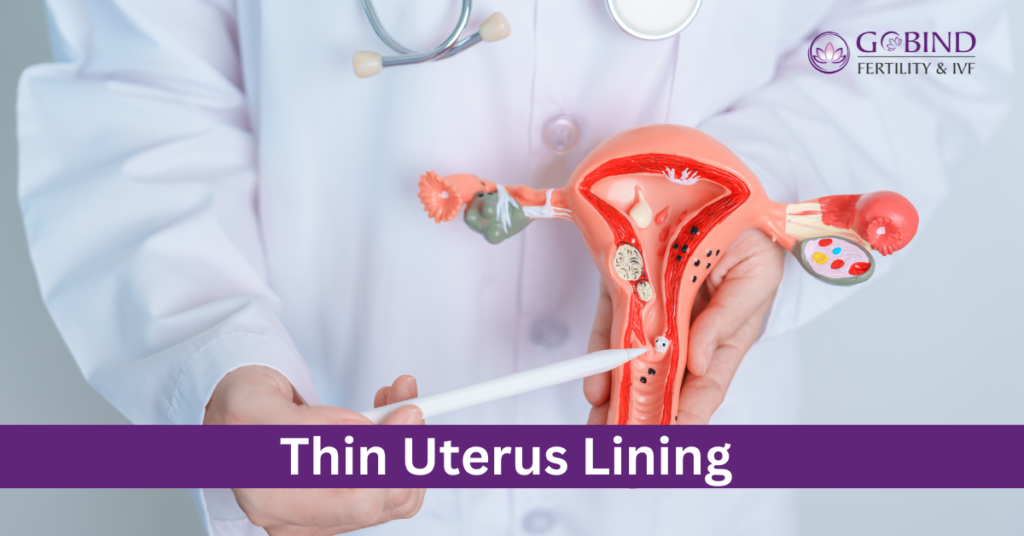What is Thin Uterus Lining: Its Symptoms and Solutions

A healthy uterus lining, also known as the endometrium, plays a crucial role in fertility and overall reproductive health. When the lining becomes too thin, it can present challenges for conception and pregnancy. In this blog, we’ll explore what a thin uterus lining is, its symptoms, and the various solutions available.
What is a Thin Uterus Lining?
The endometrium is the inner lining of the uterus that thickens each month in preparation for a potential pregnancy. If pregnancy does not occur, this lining is shed during menstruation. A thin uterus lining, or endometrial lining, is generally considered less than 7 mm thick during your menstrual cycle’s early to mid-follicular phase. An 8-14 mm thickness is typically ideal for implantation and successful pregnancy.
Symptoms of a Thin Uterus Lining
A thin uterus lining may not always present obvious symptoms, especially if it’s not affecting fertility. However, some potential signs and symptoms might include:
Irregular Menstrual Cycles: Changes in the regularity or flow of your menstrual cycle can sometimes indicate a problem with the endometrial lining.
Difficulty Conceiving: Women with a thin uterus lining may find it challenging to conceive, as the thin lining can hinder the implantation of an embryo.
Recurrent Miscarriages: If you are pregnant, a thin lining can increase the risk of miscarriage due to insufficient support for the developing embryo.
Short Menstrual Periods: A thin lining can sometimes result in shorter periods, which might be noticeable over time.
Spotting Between Periods: Unexplained spotting or light bleeding between periods can be a sign of endometrial issues.
Causes of a Thin Uterus Lining
Several factors can contribute to a thin endometrial lining:
Hormonal Imbalances: Low levels of estrogen, which is crucial for endometrial growth, can lead to a thinner lining.
Age: As women age, especially during perimenopause, the lining may become thinner and less responsive to hormonal changes.
Chronic Conditions: Conditions such as polycystic ovary syndrome (PCOS) or hypothyroidism can affect the endometrial lining.
Medications: Some fertility medications or treatments like chemotherapy can impact endometrial thickness.
Uterine Conditions: Certain structural abnormalities in the uterus, such as fibroids or polyps, can interfere with the development of a healthy lining.
Lifestyle Factors: High levels of stress, poor diet, and smoking can all potentially impact endometrial health.
Uterine Infections: Genital Tuberculosis and Pelvic Inflammatory Disease.
BOH: History of previous Miscarriages followed by D&C.
Solutions and Treatments for Thin Uterus Lining
If you suspect you have a thin uterus lining, several approaches and treatments might help:
Hormone Therapy: Estrogen supplements or hormone replacement therapy can help stimulate endometrial growth. Sometimes, progesterone is also used to help balance the hormonal environment.
Medications: Drugs like Clomid or Letrozole can be prescribed to help promote a thicker endometrial lining by stimulating ovarian function.
Lifestyle Changes: Improving diet, managing stress, and avoiding smoking can all contribute to better reproductive health and potentially improve endometrial thickness.
Acupuncture: Some studies suggest that acupuncture might help increase endometrial thickness by improving blood flow to the uterus.
Surgical Interventions: In some cases, if structural issues are affecting the lining, surgical procedures to correct these abnormalities may be necessary.
Assisted Reproductive Technologies (ART): Techniques such as in vitro fertilization (IVF) can sometimes bypass issues with the endometrial lining, especially if other treatments are not effective.
When to See a Doctor
If you’re experiencing symptoms of a thin uterus lining or have difficulty conceiving, it’s important to consult a healthcare provider. You can consult Dr Manju Khurana (Senior IVF Specialist) at Gobind Fertility & IVF Center. They can perform evaluations such as ultrasound imaging or endometrial biopsy to assess the thickness of your uterine lining and determine the most appropriate treatment plan.
Conclusion
A thin uterus lining can be a significant factor in reproductive health and fertility, but understanding its causes and available treatments can help manage and potentially overcome these challenges. If you’re concerned about your endometrial lining, a healthcare provider can offer personalized advice and treatment options to help you achieve your reproductive goals.
Remember, while a thin uterus lining can pose challenges, many women with this condition go on to have healthy pregnancies with the right care and treatment. Don’t hesitate to reach out for help and support on your fertility journey.
